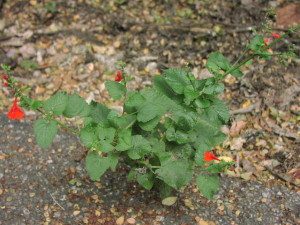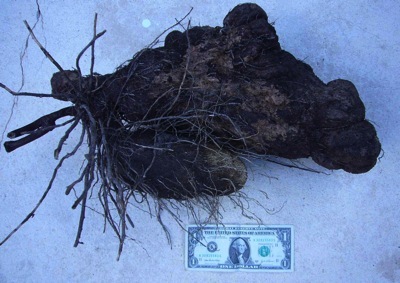
The root of the winged yam. Photo by Green Deane
It was an air potato weekend. During our Jacksonville class we dug up several pounds of Winged Yam (Dioscorea alata) roots, a yam that taste similar to potato but with a smoother texture.
If you can identify the winged Yam you will always have food to eat. Digging them up after the vine dies back for the season requires some hand scrounging to feel the telltale top. (This is always a bit fraught with danger as much soil has broken glass in it. It is safer to identify the root by the vine while in season then dig it up later. You can read more about this staple here.
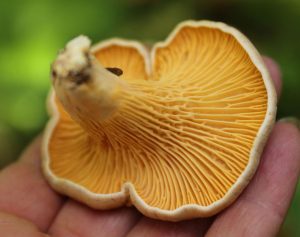
Chanterelles have wrinkles not gills.
This weekend also unintentionally was a mushrooming weekend, with several pounds available at our usual Orlando Mushroom Group location. We usually have a large mushroom flush around May but it seemed to hold off until now. We collected several pounds of Milk Caps and Chanterelles. While they can be often be found this late in the season, a huge flush of them this time of year is unusual. Perhaps we will find some in Jacksonville. Saturday.
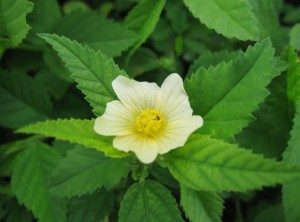
Sida has ephedrine. Photo by Green Deane
Is it Sida (SEE-dah) or is it Sida (SIGH-dah)? Either either it would seem… There are several members of the Sida genus locally and they blossom nearly all year. This weekend, however, Sida cordifolia was particularly happy. Taller and softer than some of the other genusmates, it’s a plant with a little bit of legal history. Plants in the genus tend to have ephedrine in them to varying amounts. Sida cordifolia, however, is the only Sida species mentioned in the Florida Statutes. If you make a pill using the plant it cannot be given to anyone under the age of 18. I doubt the problem is bootleg diet pills but rather youthful experimenting with ephedrine. Adults can apparently do what they want with the plant. S. cordifolia is not native. The species I see the most often is S. rhombifolia, which means diamond shape. The lower part of the leaves of that species do not have teeth on them. You can read more about Sida here.
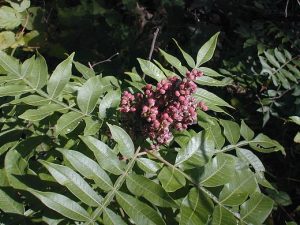
Winged Sumac. Photo by Green Deane
Our Sumacs are happy. Everywhere you go now they are sporting terminal clusters of garnet-colored berries. It is time to harvest Sumacs for use today or later. There’s a wide variety of Sumacs. Perhas 325 in the genus. Locally it’s the “Wing Sumac.” In other areas of the country it can be the Staghorn Sumac which I grew up nibbling in Maine. Shapes and quality vary but they always have terminal clusters of garnet-colored berries, give or take a hue. The berries have hair on them. And on the hair is malic acid, the acid that makes apples tart. You can rinse the acid off the acid and make a lemonade-like drink. The berries can be dried, their coating knocked off then ground and used as a spice. Surprisingly Sumacs are high in the B vitamins, including B12, but rather low in ascorbic acid which is nature’s form of vitamin C. I currently have three gallons of Sumac wine working. I hope to bring some to classes next fall. In the springtime the shoots can be peeled and eaten raw or cooked. If you are worried about Poison Sumac it grows only in wet spots, has a much different leaf, and when in fruit has white berries positioned farther down the stem, not terminal clusters. Also Poison Sumac leaves have bright red stems.
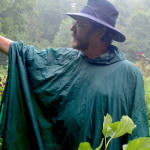
Classes are held rain or shine or cold…
Foraging Classes: If you attending the Gainesville class Saturday the weather forecast suggest you dress for nippy weather.
Oct 7th Boulware Springs Park, 3420 SE 15th St., Gainesville, FL 32641. 9 a.m. Meet at the pavilion near the pump house
Oct 8th Red Bug Slough , Sarasota. 9 a.m. Because of rennovations, we have to meet at a different location at Red Bug Slough in Sarasoata. Normally it is at 5200 S. Beneva Road. Instead we will have to park at Gypsy Street and South Lockwood Ridge Road. Gypsy can be reached by Camphor Ave which runs south of Proctor west of Beneva.
Oct 14th Dreher Park, 1200 Southern Blvd., West Palm Beach, 33405, 9 a.m. meet just north of the science center. There might be a hurricane that weekend.
Oct 15th Blanchard Park, 2451 Dean Rd, Union Park, FL 32817 9.a.m. met at the pavilion by the tennis courts.
For more information, the pre-pay for a class, or sign up go here.
In his book Edible Plants of North America, Francois Couplan writes on page 384: “the leaves of the S. lyrata, Eastern North America, contain an acrid principle and should not be ingested. They have been used to remove warts.” That said I know an herbalist who makes a tea from the leaves and a foraging instructor who cooks the young leaves and eats them. I’ve heard other reports of them being eaten. That can leave a person in a tough spotas to what to do with the plant. To eat or not to eat, that is the question.
Another example is also a sage, Salvia coccinea, also known as Tropical Sage. A small piece of the blossom of this species — a very tiny piece, 1/8 inch square — made me horribly sick for several weeks. It attacked my stomach with viciousness and I was go-to-the-emergency room miserable. Coca-cola syrup and Pepto-Bismol combined were my salvation from doubled-over pain. I was actually “field testing” this plant for edibility at the time, one reason why I am very opposed to field testing. Yet, I know of two people who have eaten the young leaves with no problem. Perhaps it was a personal allergy on my part. I don’t know. But I do know I will never eat any part of that plant again. Ever. Lesson painfully learned. Yet it might be edible, or maybe some folks really do have cast iron stomachs. I know I don’t. Eating this Sage is one of those “you’re on your own” kind of things.
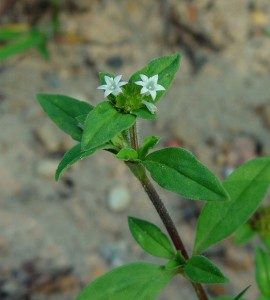
Richardia is generally not edible.
A third plant that falls into the crack between edible and not edible is Richardia scabra, aka Florida Pusley. It is in a genus that has species used to make you throw up. In fact one is called Richardia emetica. That is not encouraging. Some people mistake R. scabra for chickweed, which is a Stellaria, a totally different genus. The plants vaguely resemble each other if one ignores several details and that fact that real chickweed only grows here in the winter time. R. scabra is a species for which I have never found any ethnobotanical references to regarding edibility. In fact it is one of three common plants that seems to have either not been used by the natives or somehow were not reported. The other two are Amaranthus australis and Hibiscus moscheutos. I know from modern reports that A. australis is edible but as for the H. moscheutos I have no idea though it comes from a very edible genus. Thus R. scabra is not on my site as an edible because I can’t find any historical reference to its use. Curiously the internet now calls it “edible.” I do know two people who mistook it for chickweed and ate it for quite a while. And I know two people who did not mistake it; they know it is a Richardia and they eat it from time to time. That might be a key element. Without any ethnobotanical reference perhaps a little now and then is okay but a steady diet of it is not. It is one of those unknown things. Sometimes eating little bits of this or that do not rise to the level of making you ill. I know a person who mistook Oak Leaf Fleabane (Erigeron quercifolius) for for Plantago major and ate some for quite a while without an apparent problem. And I have personally seen someone eat a leaf of Oak Leaf Fleabane against my advice. She was still standing at the end of class. While there are some edible wild plants, and there are some that are definitely not edible, and there can be some fog in between.

You get the USB, not the key.
150-video USB would be a good end of spring present and is now $99. My nine-DVD set of 135 videos has been phased out. The USB videos are the same videos I have on You Tube. Some people like to have their own copy. The USB videos have to be copied to your computer to play. If you want to order the USB go to the DVD/USB order button on the top right of this page. That will take you to an order form. I’d like to thank all of you who ordered the DVD set over the years which required me to burn over 5,000 DVDs individually.

Green Deane Forum
Want to identify a plant? Perhaps you’re looking for a foraging reference? You might have a UFO, an Unidentified Flowering Object, you want identified. On the Green Deane Forum we — including Green Deane and others from around the world — chat about foraging all year. And it’s not just about warm-weather plants or just North American flora. Many nations share common weeds so there’s a lot to talk. There’s also more than weeds. The reference section has information for foraging around the world. There are also articles on food preservation, and forgotten skills from making bows to fermenting food.
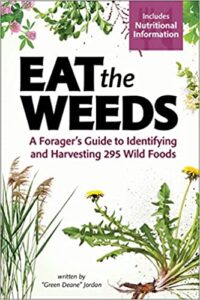 Now being printed is EatTheWeeds, the book. It should have 275 plants, 350-plus pages, index and color photos. Several hundred have been preordered on Amazon. And it is being printed now. Most of the entries include a nutritional profile. Officially it will be published December 5th (to suit the publisher publicity demands) and apparently to appeal to the winter market.
Now being printed is EatTheWeeds, the book. It should have 275 plants, 350-plus pages, index and color photos. Several hundred have been preordered on Amazon. And it is being printed now. Most of the entries include a nutritional profile. Officially it will be published December 5th (to suit the publisher publicity demands) and apparently to appeal to the winter market.
This is weekly newsletter #575. If you want to subscribe to this free newsletter you can find the sign-up form in the menu at the top of the page.
To donate to the Green Deane Newsletter click here.

